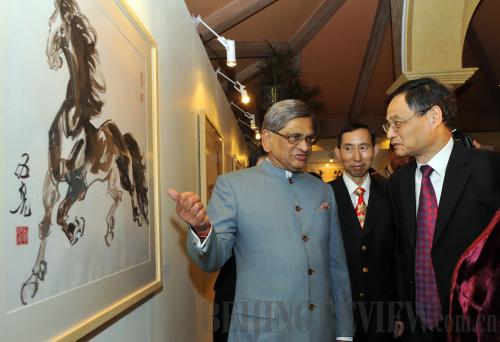|
 |
|
ARTFUL DIPLOMACY: China's Ambassador to India Zhang Yan (right) and Indian Foreign Minister S.M. Krishna admire a painting at an exhibition in New Delhi on December 23, 2009 (WANG YE) |
The simultaneous rise of China and India, the world's two most populous nations, is rightly regarded as one of the most eye-catching developments in the international arena over the past two decades.
Different voices continue to define the dual "rise" of the two countries, which share one third of the world's population between them. There can be no question, however, that the two are stronger and richer than ever before. Nor can it be denied that the influence of these nations is fast spreading around the globe.
Many believe the two nations, defined by their ancient histories, will abandon previous disputes and grow to embrace each other more fully. But it remains doubtful at best that China and India could revisit the honeymoon period they once enjoyed decades ago.
Still, by all accounts, there remains a strong prospect of the emergence of a new "Chindia" dynamic between the two powers. In the minds of many, the two nations have no other choice but to be friends.
But given the fast-evolving rise of the powers, can it be that a "Chindia"—as proposed by Bill Emmott, former editor of The Economist magazine and Indian parliamentarian Jairam Ramesh—is in the future?
Can China and India work hand in hand to participate in world affairs—and even take the helm? Or will another possible scenario materialize: that of two enemies seeking to constrain each other?
Mutual respect for history and economic improvements, however, is not sufficient for the two to forge closer relations. Moreover, a significant amount of investment in common interests in a variety of fields is needed for sound Sino-Indian relations.
But how many commonalities do the two actually share?
Sharp differences
From a strategic perspective, China has embraced the rise of India in the interest of being a strong player in a multipolar world.
Rather, with respect to China, India has evolved from a potential competitor to a competitive partner. To India, on the other hand, sound relations and cooperation with China in specific fields are helping it expand its sphere of international influence.
Both sides have grown to appreciate the need to oppose unilateralism. Both nations, meanwhile, now recognize their common interest in redefining the international political order.
But, a common vision without common actions is meaningless. For example, when it comes to their shared desire to re-establish the international order their actions have proven quite divergent.
In two very significant events—UN Security Council reforms and the expanding of developing countries' voting power at the International Monetary Fund—China and India have vastly different positions. Nor has it proven possible for the two nations to reach a shared agreement in the near future.
Clearly, no matter how urgent the need to cooperate at the international level is, self-interest has always dominated the equation.
Indeed, in some circumstances, it is more than fair to say "Chindia" does not mean "China and India"—but rather "China versus India."
Of course, the framework of the BRIC nations (Brazil, Russia, India and China) provides a trans-regional platform for dialogue between the two countries. However, despite international attention, it remains unclear what China and India have accomplished in this context as well.
When we abandon illusions of energetic global cooperation, there likewise remains a major stumbling block in Sino-Indian relations—India's uneasiness at China's warm relations with Pakistan.
New Delhi fears that close relations between China and Pakistan will cast a pall over Sino-Indian affairs—not to mention Indian national security.
Beijing, however, has vigorously contended that Sino-Pakistani relations have no designs on containing India militarily.
Upon signing the Treaty of Good Neighborliness and Friendly Cooperation between China and Pakistan by Chinese Premier Wen Jiabao and Pakistani Prime Minister Shaukat Aziz in Islamabad five years ago, most notably, much was made of the fact the agreement would not work against any third party.
Nonetheless, there remains no evidence to demonstrate that India is satisfied with this assertion. In fact, so far, India has consistently regarded every improvement in relations between China and Pakistan as being detrimental to its own regional interests.
India has voiced its hope that China will strike a more balanced policy in South Asia. On many occasions China has responded that it treats all countries in the region equally. But in the end, trust continues to be a lamentably rare commodity between the two nations.
This is unfortunate, given that both countries are in true need of close relations for regional concerns alone.
For example, India expects China to help it with its integration into the Association of Southeast Asian Nations. China, meanwhile, expects support from India with which it can participate in its own integration into the South Asian Association for Regional Cooperation (SAARC). Nevertheless, in the two most recent SAARC summits, India continued to maintain a chilly attitude toward China.
Antiterrorism, of course, is another key area in which the two nations have frequently emphasized regional cooperation. Both countries have been confronted with terrorist and separatist activities. But the nature of the terrorist organizations that they face remains quite different.
Terrorist networks threatening China mainly originate from the "East Turkistan" organizations. Those targeting India, on the other hand, largely emanate from Indian-controlled Kashmir. Since the two have such divergent agendas, their antiterrorist cooperation has seldom surpassed anything but symbolic significance.
| 